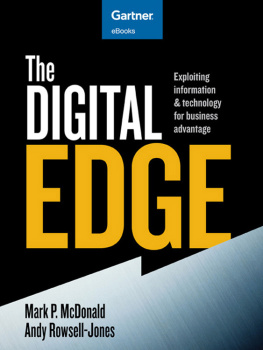Table of Contents
Guide
Pagebreaks of the print version
Management on the Cutting Edge Series from MIT Sloan Management Review
Edited by Paul Michelman
Published in cooperation with MIT Sloan Management Review
The AI Advantage: How to Put the Artificial Intelligence Revolution to Work
Thomas H. Davenport
The Technology Fallacy: How People Are the Real Key to Digital Transformation
Gerald C. Kane, Anh Nguyen Phillips, Jonathan Copulsky, and Garth Andrus
Designed for Digital: How to Architect Your Business for Sustained Success
Jeanne W. Ross, Cynthia M. Beath, and Martin Mocker
Designed for Digital
How to Architect Your Business for Sustained Success
Jeanne W. Ross, Cynthia M. Beath,
and Martin Mocker
The MIT Press
Cambridge, Massachusetts
London, England
2019 Massachusetts Institute of Technology
All rights reserved. No part of this book may be reproduced in any form by any electronic or mechanical means (including photocopying, recording, or information storage and retrieval) without permission in writing from the publisher.
This book was set in Stone Serif and Stone Sans by Westchester Publishing Services. Printed and bound in the United States of America.
Library of Congress Cataloging-in-Publication Data
Names: Ross, Jeanne W., author. | Beath, Cynthia Mathis, author. | Mocker, Martin, author.
Title: Designed for digital : how to architect your business for sustained success / Jeanne W. Ross, Cynthia M. Beath, and Martin Mocker.
Description: Cambridge, MA : MIT Press, [2019] | Series: Management on the cutting edge | Includes bibliographical references and index.
Identifiers: LCCN 2018059707 | ISBN 9780262042888 (hardcover : alk. paper)
Subjects: LCSH: Information technology--Management. | Entrepreneurship--Technological innovations.
Classification: LCC HD30.2 .R6637 2019 | DDC 658--dc23 LC record available at https://lccn.loc.gov/2018059707
Contents
List of figures
Five building blocks for a digital transformation
Digital offering: customer desires intersect with solutions
Siloed systems, processes, and data
Operational backbone
Depiction of a digital platform
Operational backbone and digital platform are linked
Management principles for designing digital accountabilities
Key mechanisms in an accountability framework
Ecosystem enabled by an external developer platform
Westpacs depiction of how its external developer platform works
The digital building blocks (as introduced in chapter 1)
PI Chiles development of digital building blocks (author interpretation)
Schneider Electrics building block development (author interpretation)
Royal Philipss building block development (author interpretation)
DBS building block development (author interpretation)
Four operating models
List of Tables
Contrasting Requirements of the Operational Backbone and the Digital Platform
Series Foreword
The world does not lack for management ideas. Thousands of researchers, practitioners, and other experts produce tens of thousands of articles, books, papers, posts, and podcasts each year. But only a scant few promise to truly move the needle on practice, and fewer still dare to reach into the future of what management will become. It is this rare breed of ideameaningful to practice, grounded in evidence, and built for the future that we seek to present in this series.
Paul Michelman
Editor in chief
MIT Sloan Management Review
Preface and Acknowledgments
As consumers, we take digital technologies for granted. No longer are we impressed that anytime, anywhere, we can shop, hire a ride, reserve a table at a restaurant, pay our bills, view a favorite movie, find a new recipe, or learn popular remedies for our latest ailment. We dont wonder why these things are possible; we simply expect them.
If youre working in a big, old company, you know that the adoption of digital technologies in business doesnt come as naturally. Inserting digital technologies to enhance operations and create new value propositions has proven extremely challenging. This raises the question: If digital technologies are consistently making our consumer lives easier, why arent they making it easier to succeed in business? Why are business leaders anxious about digital disruption rather than marveling about how quickly they can provide new, exciting, and ever-improving digital solutions to their customers?
Five years of research have led us to believe that the answer to these questions is this: Big, old companies are simply not designed for digital .
Business leaders have long taken responsibility for defining strategy, establishing structures, and measuring outcomes to make their companies successful. They are less likely to own responsibility for designing the interactions among their people, processes, and technology to ensure their companies can execute new digital strategies. We argue that business leaders cannot just hope that all the activities in their companies will coalesce in ways that will enable them to figure out how to solve customer problems and rapidly deliver new, digitally inspired value propositions. They must design their companies for digital success.
That is why we wrote this book. In our research at big companies, we found that, although digital is all about speed, a digital transformation is a long journey. Thats because it requires you to (re)design how your company works. While no company has completed the entire journey, a small number of companies are leading the way. By sharing their combined stories and analyzing their experiences, we hope to provide some direction for your journey.
Digital technologies are game changing. Leaders of big, old companies cannot rely on old rules to play this new game. The talents, skills, processes, systems, and roles that made your company successful in the past are quickly becoming irrelevant. If your big old company is going to compete in the digital economy, you must redesign for digital. Nobody says its easy. But now is the time to get started.
The Research
We were driven to this research by our fascination with enterprise architecturehow companies are designed to execute their strategies. Although most IT leaders have embraced enterprise architecture as a way of mapping a companys IT investments and business process changes, other leaders have been less interested in the topic. We expected that the dawn of digital businesses would lead to widespread embrace of enterprise architecture as a critical senior management tool. We set out to study that phenomenon.
To be honest, thats not what has happened. At least, thats not what happened at most companies. We started the research in 2014 with interviews at 40 large companies about how they were approaching business architecture. Invariably, we were directed to business architects in the IT unit, not a member of the top management team. The most telling finding from that first phase of the research was how hopeful the architects wereand how common it was for them to feel their efforts were not having a significant impact on their companies.
We followed up that set of interviews with mini case studies conducted at 27 companies in 2015 and 2016. Working with the Boston Consulting Group (BCG), we conducted three interviews at each of these companiesusually with a senior business executive, a senior IT executive, and a third person who was engaged in implementing digital strategy. Most of the companies involved in this phase of the study were starting to articulate digital strategies and taking some initial steps to implement them. In the summer of 2016, we conducted a survey of 171 business leaders to better understand the state of the art.








